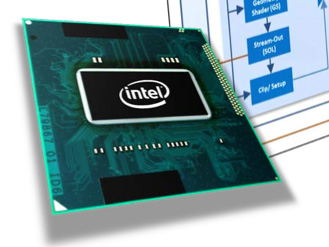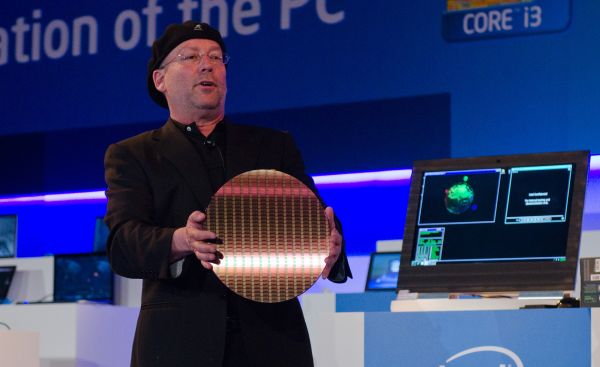Intel's Ivy Bridge Architecture Exposed
by Anand Lal Shimpi on September 17, 2011 2:00 AM EST- Posted in
- CPUs
- Intel
- Ivy Bridge
- IDF 2011
- Trade Shows
Five years ago Intel announced its ambitious tick-tock release cadence. We were doubtful that Intel could pull off such an aggressive schedule but with the exception of missing a few months here or there tick-tock has been a success. On years marked by a tick Intel introduces a new manufacturing process, while tock years keep manufacturing process the same and introduce a new microprocessor architecture. To date we've had three tocks (Conroe, Nehalem, Sandy Bridge) and two ticks (Penryn, Westmere). Sampling by the end of this year and shipping in the first half of next year will be Intel's third tick: Ivy Bridge.

Ivy Bridge (IVB) is the first chip to use Intel's 22nm tri-gate transistors, which will help scale frequency and reduce power consumption. As we already mentioned, mobile Ivy Bridge will be the first Intel CPU to bring four cores into a 35W TDP.
At a high level Ivy Bridge looks a lot like Sandy Bridge. It's still a monolithic die that features an integrated GPU. The entire die is built at 22nm, continuing Intel's march towards truly addressing integrated graphics performance. Ivy Bridge won't get rid of the need for a discrete GPU but, like Sandy Bridge, it is a step in the right direction.

Intel hasn't announced die size but transistor count has increased to approximately 1.4 billion (layout). This is up from 1.16 billion in Sandy Bridge, a 20.7% increase. With perfect scaling a 22nm Sandy Bridge die would be 47.3% the size of a 32nm die. Even with the increase in transistor count, it's a good bet that Ivy Bridge will be noticeably smaller than Sandy Bridge.
Motherboard & Chipset Support
Ivy Bridge is backwards compatible with existing LGA-1155 motherboards, although there will be a new chipset for Ivy Bridge and new motherboards to enable some features (e.g. PCI Express 3.0, native USB 3.0). The new chipset family falls under the 7-series banner. We'll see Z77, Z75, H77, Q77, Q75 and B75 available at or around launch.
| Chipset Comparison | ||||||||
| Z77 | Z75 | H77 | Z68 | P67 | H67 | |||
| CPU Support |
IVB LGA-1155 |
IVB LGA-1155 |
IVB LGA-1155 |
SNB/IVB LGA-1155 |
SNB/IVB LGA-1155 |
SNB/IVB LGA-1155 |
||
| CPU Overclocking | Yes | Yes | No | Yes | Yes | No | ||
| CPU PCIe Config |
1 x16 or 2 x8 or 1 x8 + 2 x4 PCIe 3.0 |
1 x16 or 2 x8 PCIe 3.0 |
1 x16 PCIe 3.0 |
1 x16 or 2 x8 or 1 x8 + 2 x4 PCIe 3.0 |
1 x16 or 2 x8 PCIe 3.0 |
1 x16 PCIe 3.0 | ||
| Processor Graphics Support | Yes | Yes | Yes | Yes | No | Yes | ||
| Intel SRT (SSD caching) | Yes | No | Yes | Yes | No | No | ||
| RAID Support | Yes | Yes | Yes | Yes | Yes | Yes | ||
| USB 2.0 Ports (3.0) | 14 (4) | 14 (4) | 14 (4) | 14 | 14 | 14 | ||
| SATA Total (Max Number of 6Gbps Ports) | 6 (2) | 6 (2) | 6 (2) | 6 (2) | 6 (2) | 6 (2) | ||
| PCIe Lanes | 8 (5GT/s) | 8 (5GT/s) | 8 (5GT/s) | 8 (5GT/s) | 8 (5GT/s) | 8 (5GT/s) | ||
As I mentioned above, Ivy Bridge finally supports USB 3.0 natively. The consumer 7-series chipsets feature 14 total USB ports, 4 of which are USB 3.0 capable. The CPU itself features 16 PCIe (1x16, 2x8 or 1x8 + 2x4) gen 3 lanes to be used for graphics and/or high performance IO. You will only see Gen 3 speeds on qualified motherboards. It's technically possible on 6-series motherboards but guaranteed on 7-series motherboards. The Z77 and H77 chipsets will support Intel's Smart Response Technology (SRT, aka SSD caching) which is a Z68 exclusive today.
SATA and chipset-attached PCIe slots haven't changed. Overclocking is supported on all Z-chipsets, while the H-chipset doesn't. All chipsets support Intel's HD Graphics, which is a departure from the Sandy Bridge mess where P67 didn't.










97 Comments
View All Comments
medi01 - Sunday, September 18, 2011 - link
It's been a while that most users didn't really need faster CPUs or GPUs.In a couple of years, why on earth would anyone but gamers need a PC? Emails, browsing, video would be covered by tablets and the likes.
dealcorn - Friday, November 4, 2011 - link
My Suzuki Alto has about the horsepower of a team of mules and it's fine, really. However, if for about the same money and fuel economy I could get 600 hp, darn right I need 600 hp. That's about where we are at with CPU power. I believe your issue is more properly stated as "there is a need to re engineer humanity because it is not doing what I want."Billy_Boy - Saturday, September 17, 2011 - link
"In Sandy Bridge, many of those structures are statically partitioned. If you have a buffer that can hold 20 entries, each thread gets up to 10 entries in the buffer. In the event of a single threaded workload, half of the buffer goes unused."If you turn off HT does this go away in Sandy Bridge?
BioTurboNick - Saturday, September 17, 2011 - link
They are talking about a hardware implementation, so it wouldn't go away by disabling hyper-threading.Zoomer - Saturday, September 17, 2011 - link
It depends if the designers thought it would be important enough to implement. Losing 1/2 of the many resources (though probably not execution resources) is huge, and on a non-HT chip it's almost like castrating it.BioTurboNick - Saturday, September 17, 2011 - link
Right. That's probably why Ivy Bridge is moving to completely single-thread-capable resources.danjw - Saturday, September 17, 2011 - link
I am wondering if Ivy Bridge will be faster for gaming then the Sandy Bridge-E. I lot of the improvements seem to be with threading, but more games are starting to implement threading. Sandy Bridge-E will have PCI-Express 3.0 and more memory channels, but Ivy Bridge will have faster memory.Hrel - Saturday, September 17, 2011 - link
Will Intel FINALLY be turning on hyper threading on every CPU? Cause if not that's the final straw that breaks the camels back, I'm going AMD. It took them years to finally get a decent quad core down to 200 bucks, but then if you wanted HT it cost another 100 bucks. Ridiculous. I want to be able to buy a K series quad core with HT for under 200 bucks. Also WHY are there USB 2.0 ports on this AT ALL?If AMD has all usb 3.0 ports and the CPU performance is comparable I'm def switching camps.
Do you guys know if AMD has any plans on releasing SSD caching on their motherboards too? Cause that really is a "killer app" so to speak. Large SSD's are too expensive to make any sense unless you're filthy rich but 64GB with two 2TB HDD's in RAID sounds pretty great.
philosofool - Saturday, September 17, 2011 - link
When AMD releases serious competitors at the relevant price points. I hope bulldozer kicks ass, because a solid quad core will be two hundred bucks until there is real competition.medi01 - Sunday, September 18, 2011 - link
If you count motherboard price in, AMD is already more than competitive.